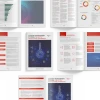The evolving landscape of CMS costs
The world of CMSs is not a static one; it’s a dynamic landscape influenced by technological advancements, market trends and evolving user experience needs. As CMS platforms grow increasingly sophisticated, the costs associated with maintaining and upgrading these systems have also risen. This evolution means that what may seem like a cost-effective solution today could turn into a financial burden down the line. Therefore, a clear understanding of how CMS costs are evolving is crucial for making an informed, future-proof decision.
Across the board, organizations identify data security and compliance (35%), development (16%) and maintenance (13%) as the primary cost drivers associated with their chosen CMS.
In the first year, 25% of organizations prioritize data and security compliance as a significant cost consideration, followed closely by resource costs for development and customization work (22%). As CMS usage extends, costs tend to diversify further, with various cost drivers—such as data and security compliance, maintenance and support, as well as resource expenses for development, customization and marketing—contributing between 11% and 19% of the overall CMS costs.
Key cost drivers in CMS
When evaluating the TCO of a CMS, several cost drivers come into play:
- Implementation, maintenance and support: The initial setup is just the tip of the iceberg. You’ll also need to consider the costs of ongoing maintenance, which includes software updates, troubleshooting and potential system overhauls. These are not one-time expenses but recurring costs that can significantly impact your budget.
- Hosting: Whether you opt for on-premise or cloud hosting, this is a recurring expense. Costs can vary based on data storage needs, bandwidth usage and the level of technical support required.
- Internal educational and knowledge-sharing efforts: Training is often an overlooked cost. It’s not just about the initial orientation but also about ongoing education. As the CMS updates and adds new features, your team will need to keep up. This involves not just time but also resources, both of which translate to costs.
- Fluctuating costs over time: Unlike fixed costs like hosting, some expenses evolve over time. For instance, data and security compliance become a significant cost consideration for 25% of organizations in the first year of CMS usage. As your organization grows and regulations change, these costs can fluctuate.
Technical infrastructure and resource prerequisites
Before you even start comparing CMS options, take a step back and evaluate your existing technical infrastructure. Do you have the servers, databases and networking hardware to support your chosen CMS? What about human resources? Do you have in-house experts who can manage and maintain the system, or will you need to outsource? These are critical questions that can significantly influence your TCO.
Vendor lock-in and flexibility
Vendor lock-in is a real concern. Once you invest in a particular CMS, switching to another can be both complicated and costly. Therefore, it’s crucial to assess the flexibility of a CMS. Can it adapt to your future needs? Is it easy to migrate your data to another system if the need arises? Make sure to consider these factors to avoid potential vendor lock-in scenarios.
CMS is critical from a content management perspective and targeting the highest value customer. You want to be able to make content once and reuse it. Digital presence is becoming more important in the application ecosystem. Once the digital component came into play, we had a way to tie communication strategy with digital strategy. These platforms are delivering on this promise of tying digital channels together with the traditional channels to create a seamless customer experience.
Security and data privacy
In an era where data breaches are increasingly common, security can’t be an afterthought. Ensuring robust data security measures is essential, not just for protecting your organization but also for complying with evolving regulatory standards. Failing to meet these standards can result in hefty fines, adding an unexpected cost to your TCO.
Scalability
Your CMS needs to grow with you. As your organization expands, your content and user engagement will likely increase. A CMS that can’t scale to meet these demands is not just an operational hindrance but also a financial burden. You’ll end up investing in extensions, plugins or even a new CMS, all of which add to your TCO.
Conclusion
Understanding the total cost of ownership is not a one-time exercise; it’s an ongoing process. It involves not just calculating the upfront costs but also understanding how these costs will evolve over time. By taking a comprehensive view of TCO, technical and digital buyers can make an informed decision that aligns with both their immediate needs and long-term organizational goals.








